
“King Street Station and the Stadiums” by Oran Viriyincyis licensed under CC BY-SA 2.0.
I listen to the Effectively Wild baseball podcast religiously. Generally, though, I despise sports commentary. I associate it with red-faced former athletes ranting about heart, hustle, and generalities concerning who’s a winner and who’s a loser. They recycle a tiresome collection of arguments, invariably returning to the trope that anyone who didn’t play the sport professionally can offer no insight. Effectively Wild is different.
The podcast regularly features questions from listeners. On episode 396, a listener named Vinit asked this question:
“If baseball were different, how different would it be? Would it only be slightly different or VERY different?”
This may seem tautological, but that first sentence has become recognized as the ethos of Effectively Wild. Tacking some clumsy exposition onto it: if baseball—as a collection of rules—were different, how different would baseball—as something that a viewer experiences—be. In contemplating this, one of the podcast’s hosts cited the introduction of the designated hitter. From the perspective of the rules, it was a monumental change. It created an entirely new role for a player to fulfill, and broke the invariant that every player on the field is also a batter. But a baseball fan who went into a coma in 1972—right before the rule took effect—and awoke this past season would still recognize the game of baseball. Any confusion would be momentary and easily resolvable. The hosts concluded that most single changes that a person could contemplate would produce only minimal change in the experience of baseball. I don’t think Vinit asked the question solely to get a response, though, but to cheekily offer an observation about the podcast. Effectively Wild is happy to indulge a hypothetical.
Sometimes, the hypotheticals are frivolous and fantastical. Some have involved star outfielder Mike Trout with an extra arm growing out of his head, a baserunner who can’t stop running once they start, or placing a pit on the field of play. When the hosts consider these questions, they don’t criticize the listener because Mike Trout doesn’t and will never have three arms, stupid. They accept the premise and reason about what would happen. Sometimes a player conferred some fanciful ability will initially seem game-breaking, until a prolonged discussion reveals that the player might actually make their team worse. There is a joyful commitment to the act of inquiry, no matter how outlandish an idea is.
“So there’s a baseball podcast where some nerds think through dumb crap that will never happen,” thinks the uncharitable reader at this point. “It’s not as though puzzling through the implications of a pit on the field can change anything about baseball. What does a podcast about baseball—an activity that exists only to entertain—have to do with public transit, something that actually matters in sustaining the lives and livelihoods of people.”
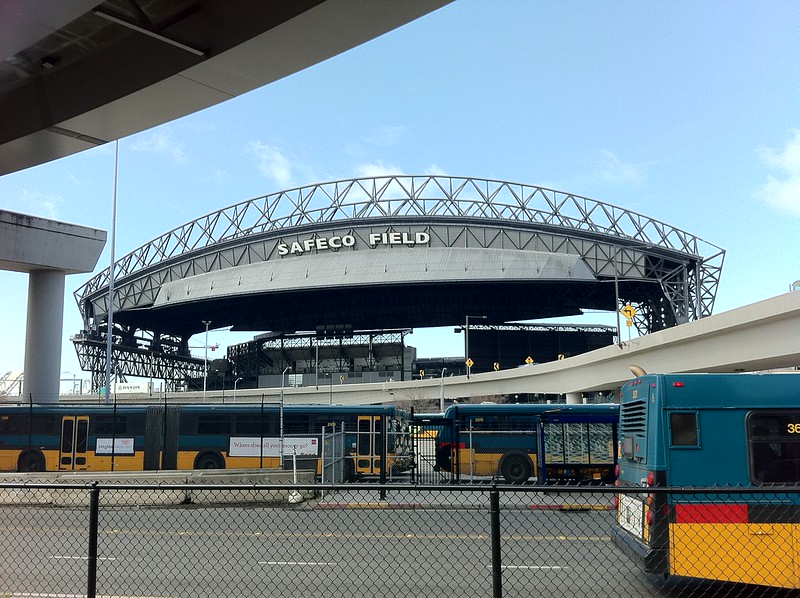
“Safeco Field seen from Stadium Station” by sillygwailo is licensed under CC BY 2.0.
I believe that thought, in any area, is a skill that benefits from exercise. Baseball is not a static game; the past years, in particular, have brought rule changes. Even in the absence of these, player behavior and skillsets can be altered by trends outside the game. If I’m seeking insight into how my baseball viewing experience will change, I’m more inclined to trust people with experience mixing the absurd with reality. The practice that they have makes them better at assessing something new than the former athlete who has only been asked to reflect on their playing days.
It’s also important to view Effectively Wild’s spirit of inquiry as part of a longer tradition. One could see its beginning in the founding of the Society for American Baseball Research in 1971, the works of Bill James of the late 70s, or discussions on the early Internet’s rec.sport.baseball Usenet newsgroup. Critical mass began to emerge around questioning whether the people running baseball teams were making the best decisions when it came to winning games. They called into question the conventional wisdom that governed teams for decades. Slowly, these ideas worked their way into baseball organizations. The book, and later movie, Moneyball recount the beginning of the rejection of entrenched baseball ideology within the Oakland Athletics organization. Bill James was hired as an advisor by the Boston Red Sox in 2003. Analytical blogs by baseball outsiders began to flourish around this time too. By the mid 2010s, public baseball analysis websites like FanGraphs were regularly losing their writers to jobs within baseball teams. What was once the domain of former players and the drinking buddies of team owners is now staffed with curious people having backgrounds ranging from astrophysics to poetry.
The Moneyball movie, in particular, brought this chronicle into the mainstream, but I think many people misunderstand the actual shift in baseball that took place. It’s often conceived of as a quantitative approach replacing a qualitative one—“stats versus scouts"—but there were plenty of baseball statistics in use before the 1970s. Players have been evaluated and compared using batting averages and runs batted in since the turn of the 20th century. The shift was not the introduction of numbers to baseball, but to question whether the statistics already in use were the best tools to assess a player’s talent and their impact on winning baseball games. It wasn’t even that the outsiders were championing stats necessarily more complex than the existing ones. On-base percentage—a favorite of early public analysts, and what Moneyball portrays as Oakland’s secret weapon—is simpler to compute than batting average.
The traditional statistics incorporated value judgements not supported by reality. Most batters consider getting a hit to be their goal, so batting average is only improved when a player gets on base with a hit. To use it tacitly assumes that all other ways that a player can get on base are either unimportant, or do not meaningfully vary among players. In reality, batters draw walks, and even get hit by pitches, at rates that are significantly different, and are too consistent year-over-year to be the result of random chance. While non-hit outcomes don’t have the impact of the most valuable hits, they still put a runner on base and don’t burn through the team’s finite supply of outs. On the other hand, runs batted in, or RBIs, reward players for circumstances that they cannot control. A player’s ability to drive in a run depends on how many runners are already on base, and their ability to advance those runners. The game state that the batter finds themself in is completely out of their control. On top of that, a player being clutch—rising to the occasion by being better in a situation where they have runners to drive in—does not show any season-to-season correlation. A player may have a season wherein they were clutch in retrospect, but they are not intrinsically clutch or unclutch. An RBI total can heap value on a player who has merely been lucky. Contrast these with on-base percentage. It’s a simple measurement, devoid of the complications of context. It’s not a total encapsulation of player skill, of course; it values all on-base events equally when home runs are obviously better than walks. Compared to batting average, though, it counts more of the outcomes that improve the game state for the batting team, rather than just counting the things that batters are “supposed to” do. A lack of reverence towards established traditions helped outsider analysts see that.

“Disembarking at Stadium Station” by Oran Viriyincy is licensed under CC BY-SA 2.0.
Effectively Wild can give time to zany hypotheticals because it stands atop work done by those who preceded it. The pioneers of baseball research were also asking “if baseball were different, how different would it be?” They were less concerned with the impact of a cartoonishly relentless baserunner, and more focused on what could happen if decision makers used different measurements to evaluate players and tactics. But, at the time, deemphasizing batting average probably seemed as bizarre as placing a pit on the field. People deigning to think that way were characterized by baseball columnists as eggheads living in their parents’ basements. Now, people like them are essential to running baseball teams. Their inquisitive way of thinking changed baseball.
2023 in Review
Throughout 2023, I was working towards answering a question evocative of Effectively Wild’s mindset. What if a transit network in Seattle were built to maximize the most raw form of access: the ability to move throughout the city regardless of the time of day, one’s starting point, or desired destination? It wasn’t clear to me what a network explicitly designed to increase this measurement would look like. Would the access increase by a lot or a little? How often would transit vehicles come if they arrived at the same frequency at every stop? If public transit were different, how different would it be? Would it only be slightly different or VERY different? The question isn’t exactly the transit equivalent of a three-armed Mike Trout, but it’s a substantial departure from the ways that King County Metro thinks about its transit network.
In theory, conventional network design starts with identifying areas of residential density and the demand nodes that people are trying to reach. From there, projections estimate when and where people want to travel. When many people are expected to travel between two points, more capacity is added by making the route between them run more frequently. This is done to avoid overcrowding. When few people are, fewer vehicles run over the course of the day. This is to prevent vehicles from running with a low passenger load. There’s a superficial logic to it.
In practice, I assert that this approach has major problems. The relationship between frequency and capacity is clunky and has secondary consequences. It’s not guaranteed that people will spread themselves among the new trips added to a busy route. Their need to travel might be time sensitive. This is more sinister in the inverse direction, where agencies will cut trips on unpopular routes, in hopes of achieving a greater number of riders per vehicle. As trips are canceled, though, it gets more difficult to reach a place near a specific time. On a route with hourly frequency, a person might be forced to arrive 59 minutes before their appointment. An infrequent route enters a death cycle where worse service results in fewer riders, bringing further cuts. Frequency does have a relationship to capacity, but it’s more directly tied to convenience.
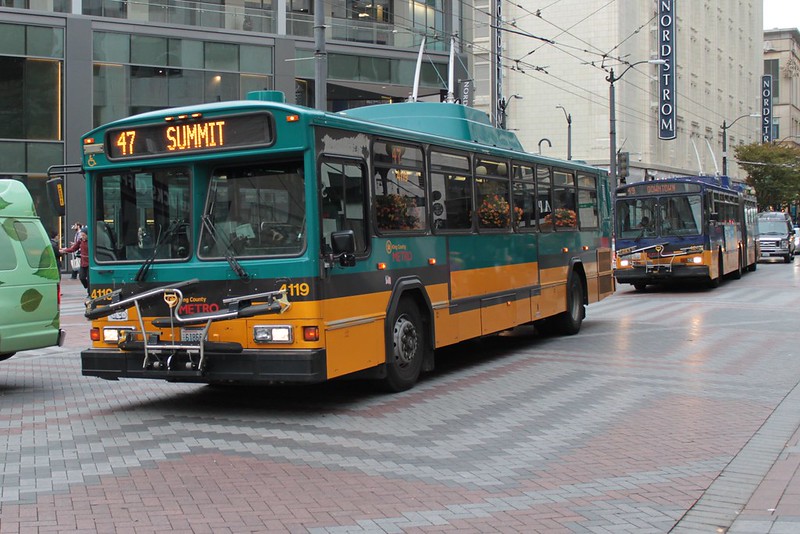
“King County Metro trolleybuses on Pine Street” by SounderBruce is licensed under CC BY-SA 2.0.
Complicating this further is that the existing routes aren’t coming from up-to-date information on precisely what people are doing. Plenty of King County Metro routes are near-replicas of erstwhile streetcar lines from the turn of the last century. These were developed to lure well-off people to then-outlying residential developments, giving them access to a downtown that was more residential and commercial than the office-centric one that exists today. Nowadays, it makes commutes the most convenient type of trip for using transit. Because demand provokes increases in frequency, and frequency attracts new riders with its convenience, the commute focus gets reinforced. On top of that, many people avoid public transit trips that are inconvenient, providing little signal of where potential new ridership could come from. The agency’s own guidelines hinder breaking out of the patterns that the early network established.
The end result is damned by the process that built it. The network that currently exists isn’t aligned with what people want to do. According to the Bureau of Transportation Statistics, only 15% of trips are for commuting. Shopping and errands comprise 45%, and while some opportunities to do that exist in the downtown core, there isn’t even a conventional supermarket there. Social and recreational trips comprise 27%; a good portion of which are likely to be between primarily residential areas. Yet Metro’s routes in Seattle make it most convenient to get from residential neighborhoods to downtown during the traditional rush hours. It contributes to an 81% vehicle ownership rate in the city because there are desirable trips that the public transit network doesn’t make easy. Roads become congested by car traffic, and Seattle’s largely bus-based network suffers reliability problems and delays.
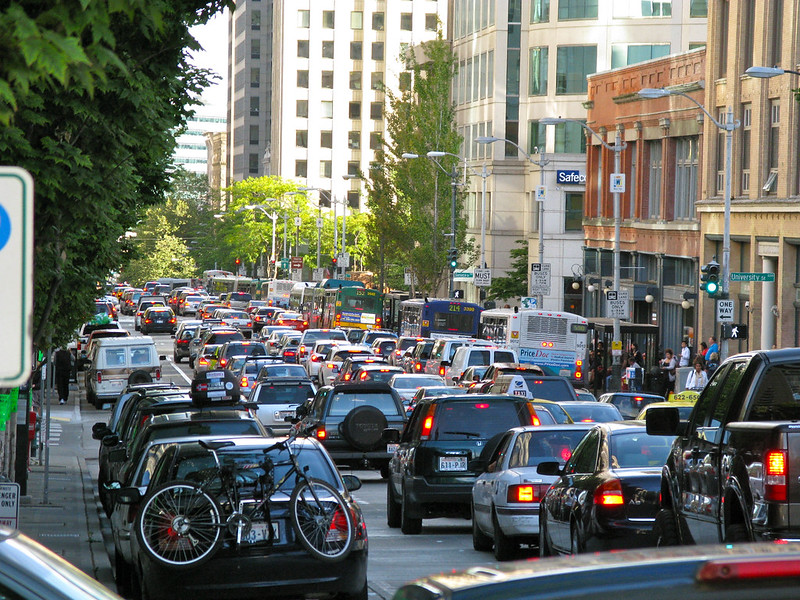
“Traffic on 2nd Avenue” by Oran Viriyincy is licensed under CC BY 2.0.
Given the problems with the status quo, I considered my question to be a serious one. Uniformly frequent service wouldn’t be a panacea, but it would help remove one way in which transit is inconvenient. Disregarding capacity altogether was a big risk to it being taken seriously, though. I didn’t do this because I believe that transit vehicles are magically capable of holding an infinite number of people. I wanted to explore committing to using frequency as a device that primarily serves convenience, and not capacity. This constraint forces capacity problems to be solved in other ways—something unconventional, but not unprecedented. When frequencies and the sizes of transit vehicles can’t expand, agencies are forced to get creative. Metro-Boston’s MBTA ran a set of seatless subway cars during the heaviest commuting time, Japan’s subway network has employed passenger arrangement staff on certain lines to achieve higher capacities on existing vehicles, and, in the recent past, King County Metro used higher peak fares to try to push non-time sensitive trips to less busy times. If a network with more-uniform frequencies would make it much easier to move throughout the city, perhaps it would make less sense to lean heavily on varying frequency as a crowding salve.
Before building this new network, I first had to better understand the measurement that I was using, and eliminate any issues with the system that I had built to compute it. I needed to look beyond the average access for the entire city, and understand how access varied throughout it. I started by looking at the distribution of access scores across Seattle’s ballot return boxes. This lead to an accidental discovery that, in my mind, reinforced that the question that I was asking could have interesting answers. I found that, though many King County Metro bus routes are focused around downtown Seattle, it isn’t the only place that has exceptional transit access. If some of the abundance of service hours allocated to downtown weren’t meaningfully increasing its access compared to other places, perhaps they could be redistributed to improve service elsewhere. This lead me to realize that my criteria for “exceptional service” were loose and ad-hoc, so I next focused on a more formal look at the distribution of access throughout Seattle. I then looked at where access to individual neighborhoods and beaches fit within the city overall, using the ways of thinking about the distribution that I had established.
While these experiments provided some insight into the distribution of access, I took a brief detour to investigate some additional properties of transit service in Seattle. These could be extracted from the same data, but required developing a different method of aggregation. To that end, I looked into how many transit routes made up the fastest trips between destinations.
A turning point in the research came when I compared Seattle’s access measurements to those of six other cities. It showed that Seattle had a larger transit investment than any of the other cities per unit of area to cover. It was the worst, however, at turning this investment into expanding the destinations that one could reach compared to a 30-minute walk. This coincided with King County Metro announcing that it would be cutting service because of a shortage of operators and mechanics. The time seemed right to build a restructured network in line with the anticipated service cuts and analyze it’s access implications. I could contrast what could happen—if Metro approached its transit network differently—with what was going to happen when service was due to be cut.

“Can’t Have Nice Things graffiti, bus shelter, Seattle, Washington, USA” by gruntzooki is licensed under CC BY-SA 2.0.
I was moderately happy with the network that I had built. It provided at least 15-minute frequency, 24 hours per day, seven days per week, at every transit stop in Seattle, and made only minimal changes to which corridors had service. For 30-minute trips, it increased access by a substantial 20% on average, and outperformed the actual network for every time budget that I tested. It also managed to use fewer in-service vehicle hours than King County Metro’s post-reduction network. I even had hours available to make some concessions to managing capacity with frequency, by giving some of the most popular routes better than 15-minute frequency 24 hours per day, seven days per week. I had made this ostensibly improved transit network, but it was no more real than a bottomless pit on a baseball diamond.
After fruitlessly trying to make King County Metro aware of these posts—unlike some transit agencies, it doesn’t have a mechanism for accepting unsolicited proposals—I decided to go to the press. I wrote an op-ed and submitted it to Seattle’s alternative weekly, The Stranger, where I thought it would match with the publication’s progressive ideals. Citing being busy with their election endorsements, that publication passed on it.
I then tried The Urbanist, a website focused on advancing urbanism in the Puget Sound area. They also chose not to run it, but I got a substantial response from the publisher. IT described my op-ed as “too extreme a version of the argument” and raised some concerns.
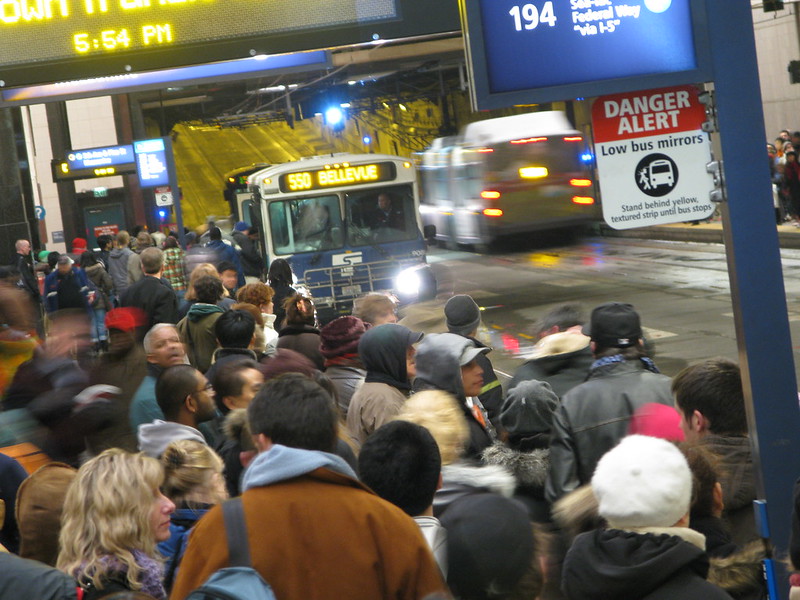
“Crowded Westlake” by Oran Viriyincy is licensed under CC BY-SA 2.0.
There was concern around crowding as a result of reducing the frequencies of certain routes at peak commuting times. The op-ed did call this out as an area that Metro would have to study if adopting the proposal. There isn’t high-fidelity public data around vehicle load for an external party to easily test this, so shutting down an experiment on the basis of potential crowding felt somewhat unfair. This concern inspired me to visualize and taxonomize frequencies by route. The results did justify some of the concern, but not so much that I felt overcrowding was an insurmountable problem, absent more data. The response, though, expressed this danger as an inevitability.
The response also pointed out that such a plan would require many more graveyard shifts. While I want to be sensitive of the impact this has, King County Metro already has seniority-based schedule selection where new operators often can’t select their desired hours. The proposal that I advanced would actually eliminate the need for split shifts—ones that require work in the morning and afternoon with an unpaid break in between—which are inconvenient in their own way. This, again, struck me as a complication rather than something that could not be solved. There was not a clear way to estimate these costs lacking inside information. But the response treated staffing an increased number of overnight shifts as a non-starter.
While I found those two arguments reasonable, if overstated, I was disheartened by a third point that the response leaned on. Making frequencies uniform would result in a mismatch between capacity and demand, particularly at night and in less-dense neighborhoods. This would lead to empty, or nearly-empty, vehicles, and this would harm farebox recovery, the amount of operating costs paid for by fares. I struggled with this line of reasoning. The response didn’t seem interested in acknowledging the good that could come from decoupling demand and frequency—it just treated it as unimaginable. I also didn’t necessarily buy the reduction in farebox recovery. Yes, on a trip-by-trip basis, added trips at night would have worse farebox recovery than those during the day, but that felt immaterial. My goal was not to decrease the number of people riding during the day. In fact I hoped that overall more trips would be taken, because the increased access meant reaching desired destinations would be more convenient. A decrease should only happen if the modified schedule resulted in vehicles that were so crowded that they could not accept passengers. To me, though, being completely assured that riders would be left behind was overconfident, and didn’t account for currently-unused approaches to capacity management.
I was invited to submit a “more measured” take. I elected not to do this right away, because I inferred that nothing involving uniform frequency would be considered “measured”. Straying from this would weaken the proposal significantly. When there are no exceptions, it’s possible to make a simple, reassuring statement to a potential rider: “find a bus stop, and under normal operations, you’ll be aboard a bus in 15 minutes.” Tying frequency to projected demand also diminishes the idea that public transit can be relied on, without supplementation, for all trips throughout the entire city. Losing those felt like a bad tradeoff. On top of that, the points that were raised about peak frequencies did make me want to look into revising the restructure. If I found ways to push the worst frequencies to 12 or 10 minutes, perhaps the overcrowding concerns would hit less hard.

“Madrona at Night: Electric Trolley Bus Outside St. Clouds” by JoeInSouthernCA is licensed under CC BY-ND 2.0.
I nevertheless wanted to elaborate on why I was comfortable decoupling demand and frequency. The op-ed didn’t go into depth on this, but it seemed to be a major stumbling block in accepting my line of reasoning. I felt coming to a common understanding, even if no op-ed was published, was important. The Urbanist takes principled stands with which I rarely disagree; I felt its staff would be looking for many of the same things out of a transit system and city that I was. These were my people, and I felt like if I couldn’t justify that a radically different approach to public transit route planning was at least worth studying, who could be convinced? I wrote a long response—so long that I sat on it awhile thinking that no reasonable person would ever bother to read it. Eventually, I decided to send it to the publisher with a disclaimer that it was long, so perhaps where I was coming from was better discussed over beer or coffee. The publisher, to my surprise, read it, and felt that I was just “doubling down” on the points I’d made already. The invitation went unacknowledged.
I’m a little reluctant to call this out, because communicating over a text-based medium is difficult and misunderstandings can occur. I shared this exchange with several people, and they all found the publisher’s tone somewhat condescending and rude. My sense was that my points were being considered from the perspective that my thought process was profoundly ignorant or naive. In response to running frequent service in neighborhoods that don’t currently have it, I was told that “[d]emand nodes really do exist and aren’t solely a function of induced demand via the transit service we provide.” Of course some areas will generate more interest than others. That doesn’t mean there can’t be a way to make even areas with low demand convenient to reach. On maintaining high frequency overnight, I was informed that “most of those buses are going to run empty because the majority of the population isn’t suddenly going to switch to a nocturnal life style.” I’d have to be pretty stupid to believe that such a shift would happen. People who are not nocturnal do sometimes need to travel at night. Now I could be totally wrong in my reading of the tone. The people who assessed the responses as condescending know and like me, so they aren’t approaching it without bias. I just can’t get over the feeling that the publisher was less interested in having a conversation as peers, and more about edifying me on why it couldn’t work. If the message was more along the lines of “prove to me that this won’t cause capacity issues” and less “15-minute service is not going to be enough in the highest-demand areas and would cause crowding issues,” I’d be working on the former right now instead of writing this paragraph.
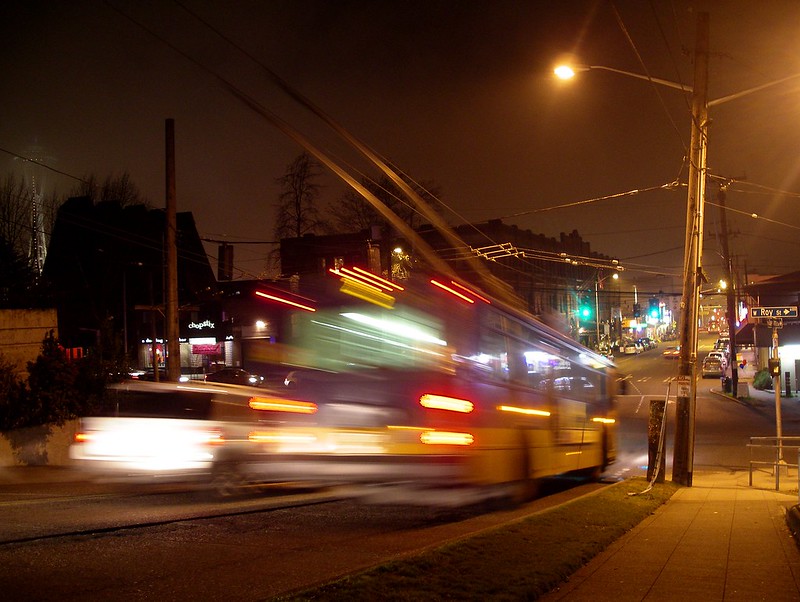
“Overhead wire in Queen Anne” by rutlo is licensed under CC BY 2.0.
In the reply to my subsequent explanation, The Urbanist’s publisher suggested that “starting from a place of greater understanding would allow for sharper insights.” This is a difficult area for me to self-assess. I don’t have formal education in transit planning. People with tech backgrounds propose awful transportation ideas. There’s a meme among transit advocates on social media of some tech bro believing that they’ve discovered an innovative new transportation technology, and it ends up being indistinguishable from a municipal bus. I get being skeptical of someone with my background advocating for selectively disregarding decades of conventional wisdom. On the other hand, I don’t think I’m approaching this field ignorantly. I had a paper published in the National Academies’ Transportation Research Record, it was selected best paper by the committee that reviewed it, and it was awarded the best overall public transit paper by an author under 35 that year. I don’t think I made any genius-level contribution to the planning field, but to be comfortable submitting a paper I needed some background. I reviewed and analyzed around 100 papers, among the first of which were manuals from the 1950s that formalized projecting demand from land use, and planning transit network expansion around that. My reviewers thought this was sufficient understanding to propose methodological changes to the planning process. Maybe I’m acting with a lack of reverence, but I don’t think there’s a lack of understanding. Or maybe I’m just an idiot. Who am I to say?
The whole experience put a shitty capstone on the year. It’s not so much that my proposal—one that King County Metro would be unlikely to act upon—didn’t appear in a local niche publication. I’ve had no luck finding a community of people that approach public transit in the way that analytical baseball fans approach the sport. I thought an op-ed in an urbanism-focused publication might reveal one. Sadly, The Urbanist is no Effectively Wild.
Because it’s not that the hosts of Effectively Wild consider every listener hypothetical to be a kernel of unimpeachable genius. Sometimes they’ll decide that a listener’s idea would make for a worse game of baseball, or that some existing statistic is a better measurement of value than one that a listener has proposed. The discussion never falls back to that’s just the way baseball is and ever shall be. It’s not that there are no bad ideas, just that ideas out of line with convention are actually worth exploring in detail instead of being reflexively denied for being unconventional. There’s just basic curiosity. If that mindset exists in Seattle’s transit advocate community, I didn’t find it in 2023.
Plans for 2024
The end of 2023 felt bad, but I’m starting 2024 having learned from it. The transit network that I proposed will not be given the benefit of the doubt. To me, the possibility of frequent service throughout a city, all day, every day, that substantially increases overall access, and all without increased investment in service hours, should be reason enough for an agency to study if the very real obstacles to implementation are surmountable. But it hasn’t been enough, and pressure won’t be coming from the members of the advocate community that I’ve interacted with so far.
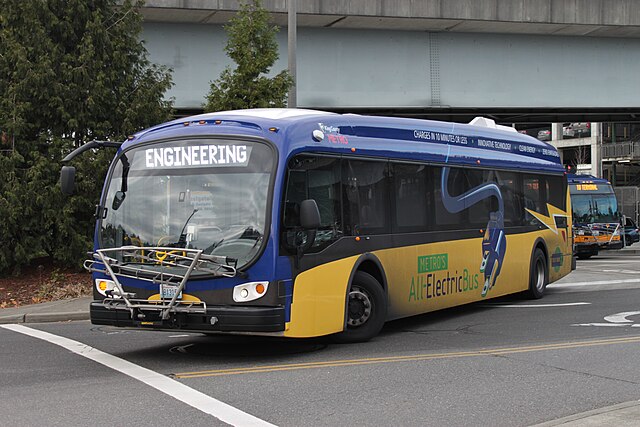
“King County Metro Proterra Catalyst electric bus leaving Eastgate P&R (22997295244)” by SounderBruce is licensed under CC BY-SA 2.0.
So this year I’m planning on researching the crowding implications of the proposal. I never intended to investigate the issue of capacity, because I felt that the party that is best able to assess it would be King County Metro itself. Ridership data is not generally available in the fidelities needed to ascertain trip-by-trip crowding. I learned to hate working with this type of data at a previous job; it’s rarely precise and often incomplete. But I’ve already requested and received some from King County Metro, and I have also asked one of its bus vendors for information on how many passengers their buses could carry in a minimal-seating configuration. I’ll never trust ridership data to be definitive, but it can provide some basic insight on whether crowding to the point of turning away riders would occur.
I’ll also be continuing work that I started last year on running King County-wide analyses. This is important for determining the impact that changes in Seattle’s transit network would have on riders outside the city. The performance and cost of analyses over areas this large currently makes this somewhat untenable. I don’t have a clear plan for improving this yet, but it is an opportunity to focus on a purely technical endeavor.
Making the restructure proposal more approachable is an absolute necessity this year. Currently, I don’t have a way of drawing route maps of the restructured network. The text descriptions of how each route is changing are overwhelming and tedious to read. As I continue to search for groups and individuals who can envision the benefit that could come from a rethought transit network in Seattle, I’ll need to make the proposal more comprehensible to a less technical audience.
Alongside of those larger themes, I’ll continue to have the flexibility to explore interesting areas of research as they come up. I get to ask weird hypothetical questions and answer them, which is great. Part of what makes that activity enjoyable, though, is the idea that it can drive change. When that doesn’t seem possible, the work can seem purposeless and stupid, and that’s how the past two months have felt. Thinking about Effectively Wild, its commitment to inquiry, and the tradition in baseball that allows it to flourish, helps. I know that change is possible; I’ve witnessed the results of it within my lifetime. I imagine those involved in that change had to have a special form of patience: one that allows one to become neither discouraged nor complacent. Baseball’s nerds persisted, and I plan to do the same.